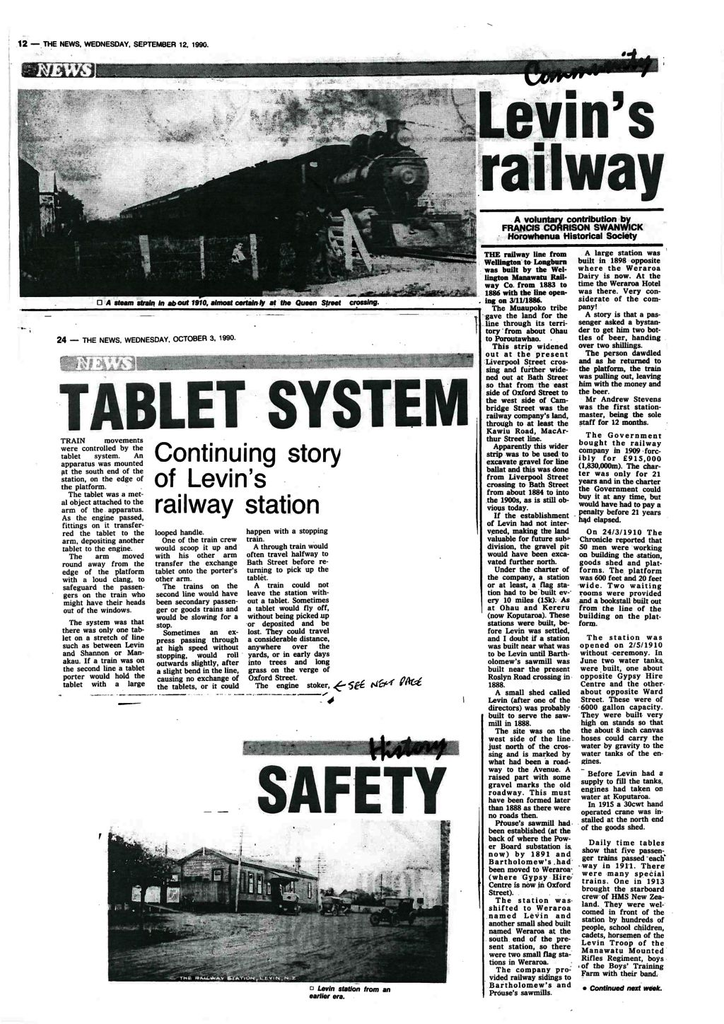Levin's Railway
- Description
 The Muaupoko tribe gave the land for the line through its territory from about Ohau to Poroutawhao.
The Muaupoko tribe gave the land for the line through its territory from about Ohau to Poroutawhao. This strip widened out at the present Liverpool Street crossing and further widened out at Bath Street, so that from the east side of Oxford Street to the west side of Cambridge Street was the railway company’s land, through to at least the Kawiu Road, MacArthur Street line.
Apparently this wider strip was to be used to excavate gravel for line ballast and this was done from Liverpool Street crossing to Bath Street from about 1884 to into the 1900s, as is still obvious today.
If the establishment of Levin had not intervened, making the land valuable for future subdivision, the gravel pit would have been excavated further north.
Under the charter of the company, a station or at least, a flag station had to be built every 10 miles (15k), as at Ohau and Kereru (now Koputaroa). These stations were built before Levin was settled and I doubt if a station was built near what was to be Levin until Bartholomews’s sawmill was built near the present Roslyn Road crossing in 1888.
A small shed called Levin (after one of the directors) was probably built to serve the sawmill in 1888.
The site was on the west side of the line just north of the crossing and is marked by what had been a roadway to the Avenue. A raised part with some gravel marks the old roadway. This must have been formed later than 1888 as there were no roads then.
Prouse’s sawmill had been established (at the back of where the Power Board substation is now) by 1891 and Bartholomew’s had moved to Weraroa (where Gypsy Hire Centre is now in Oxford Street).
 The station was shifted to Weraroa, named Levin, and another small shed built named Weraroa at the south end of the present station, so there were two small flag stations in Weraroa. The company provided railway sidings to Bartholomews’s and Prouse’s sawmills.
The station was shifted to Weraroa, named Levin, and another small shed built named Weraroa at the south end of the present station, so there were two small flag stations in Weraroa. The company provided railway sidings to Bartholomews’s and Prouse’s sawmills. A large station was built in 1898 opposite where the Weraroa Dairy is now. At that time the Weraroa Hotel was there. Very considerate of the company!
A story is that a passenger asked a bystander to get him two bottles of beer, handing over two shillings. The person dawdled and as he returned to the platform, the train was pulling out, leaving him with the money and the beer.
Mr. Andrew Stevens was the first station-master, being the sole staff for 12 months.
The Government bought the railway company in 1909 forcibly for £915,000 (1,830,000m).
The charter was only for 21 years and in the charter the Government could buy it at any time, but would have had to pay a penalty before 21 years had elapsed.
On 24/3/1910 The Chronicle reported that 50 men were working on building the station, goods shed and platforms. The platform was 600 feet long and 20 feet wide. Two waiting rooms were provided, and a bookstall built out from the line of the building on the platform.
The station was opened on 2/5/1910 without ceremony. In June, two water tanks were built, one about opposite Gypsy Hire Centre and the other about opposite Ward Street. These were of 6000 gallon capacity. They were built very high on stands so that the about 8 inch canvas hoses could carry the water by gravity to the water tanks of the engines. Before Levin had a supply to fill the tanks, engines had taken on water at Koputaroa.
In 1915 a 30cwt hand operated crane was installed at the north end of the goods shed.
Daily time tables show that five passenger trains passed each way in 1911. There were many special trains. One in 1913 brought the starboard crew of HMS New Zealand. They were welcomed in front of the station by hundreds of people, school children, cadets, horsemen of the Levin Troop of the Manawatu Mounted Rifles Regiment, boys of the Boys’ Training Farm with their band.
Special race trains brought punters to the Levin Racing Club’s meetings. I can remember seeing many hundreds of them hurrying along Oxford Street and down Mako Mako Road to the race course to put their bets on the first race. The specials would come from both directions. Race trains would also travel to the race meetings in other towns.
Large stockyards existed at the south end, on the east side capable of holding many hundreds of stock. They probably existed from about 1900. Carriage of stock was a big part of the railways business then.
There were two staff houses near the station, one being on the east side about where Central Feed Mills in Cambridge Street is now and one a little south of the Liverpool Street intersection in Cambridge Street.
On 23/2/1916 the Chronicle reported that an Auckland bound express had 1300 passengers aboard.
In 1917 some expresses did not stop at Levin owing to war restrictions.
The use of dining cars on the trains ceased and refreshment facilities were set up at some stations. These sold the famous or infamous (depending how hungry one was) railway pies, sandwiches, cakes and tea in cups so thick that light nails could have been driven in with one. These refreshments were available at certain stations, at all hours of the night, as most Auckland expresses travelled through the night.
Practically all freight travelled by rail, except for some by coastal shipping at Foxton port. Long distance carriage of goods by motor truck was very much in its infancy.
 The railways carried practically all troops during both World Wars of 1914-1918 and 1939-1945. The station was the scene of many farewells by local dignitaries to men going to camp or especially if troops were going back to camp after final leave.
The railways carried practically all troops during both World Wars of 1914-1918 and 1939-1945. The station was the scene of many farewells by local dignitaries to men going to camp or especially if troops were going back to camp after final leave. On 23/2/1921 part of the crew of a Japanese naval squadron at Wellington, came to Levin by train. They were given a civic welcome and entertained.
I remember being given a cigarette with a cardboard holder, which had never been seen in New Zealand before, by one of the sailors on the station. I kept it for years until it crumbled away.
Five hundred crew of a British naval squadron passed through the Levin Station on 1/5/1924. The train stopped for 15 minutes for local people to express goodwill. Floral button hole posies were given to each sailor, made by members of the Levin Horticultural Society. The ribbons on them were donated by local drapers and the printing on them was donated by the Chronicle.
The following story was told to me by Mr. Charles Webby. He was on the station when a train full of British troops passed through on their way home from the Boer War about 1902. He said food and fruit was provided on the station for the troops and he remembers hungrily watching them eat, being a little hungry as a 10-year boy would have been then. The troops distributed Woodbine cigarettes to the people (a very cheap English cigarette).
My memory of the station about 1920 was of an entrance to the station on the roadside from steps into a large waiting room with a ladies’ waiting room leading off on the north side. The entrance ramps and loading bays were at either end as they are now. A bookstall jutted out from the building onto the platform about 6 feet (1.8m) by about 10 feet (3m) wide. Magazines, newspapers, icecream, sweets and cigarettes were stocked. Almost all stock could be reached by the attendant sitting on a stool.
In early days the bookstall was operated by some local stationer with casual labour as it did not open all day, but according to train times. The ticket office was further south than it is now.
Cartage of dogs was catered for. There were dog pens at the south end of the station, to keep dogs in until the trains came in. There were individual dog boxes built into the guardsvans, with exterior doors. A porter would lead the dogs and put them in the boxes.
The Levin District High School would hire a train at times in the 1920s for picnics at Plimmerton. It is recorded that one train carried 1200 pupils, teachers and parents.
The station was lit by gas from 1909 until 1927 when it and the stationmaster’s house was lit by electricity. Mrs. S. McQueen was the stationmaster in 1927.
The stopping of expresses has been on and off for various reasons, over the years, which always aroused public protest. One meeting in 1925 filled the Century Hall. The expresses had stopped for the previous 20 years, except during World War 1 and the people did not like the expresses not stopping. The trains were considered very important.
As no results were obtained, another meeting was held, which the Prime Minister attended. To him the Mayor said: “Sir, you are preventing our population from increasing.” The big audience shrieked with laughter, the Mayor said he meant that with the expresses not stopping, prevented immigrants from other parts of New Zealand. Mr. Massey said he would have the Napier Express stop again and in time the other expresses resumed stopping again.
After the subdivision of the Bartholomew mill paddock in 1925 in Weraroa, the Railway built quite a number of rental houses, perhaps up to six in Keepa Street.
Identification
- Date
- September 12, 1990
Creation
- Created By
- Corrie Swanwick
Object rights
Taxonomy
- Community Tags

